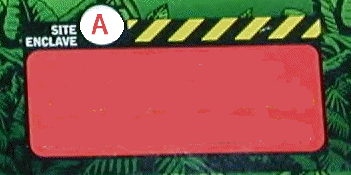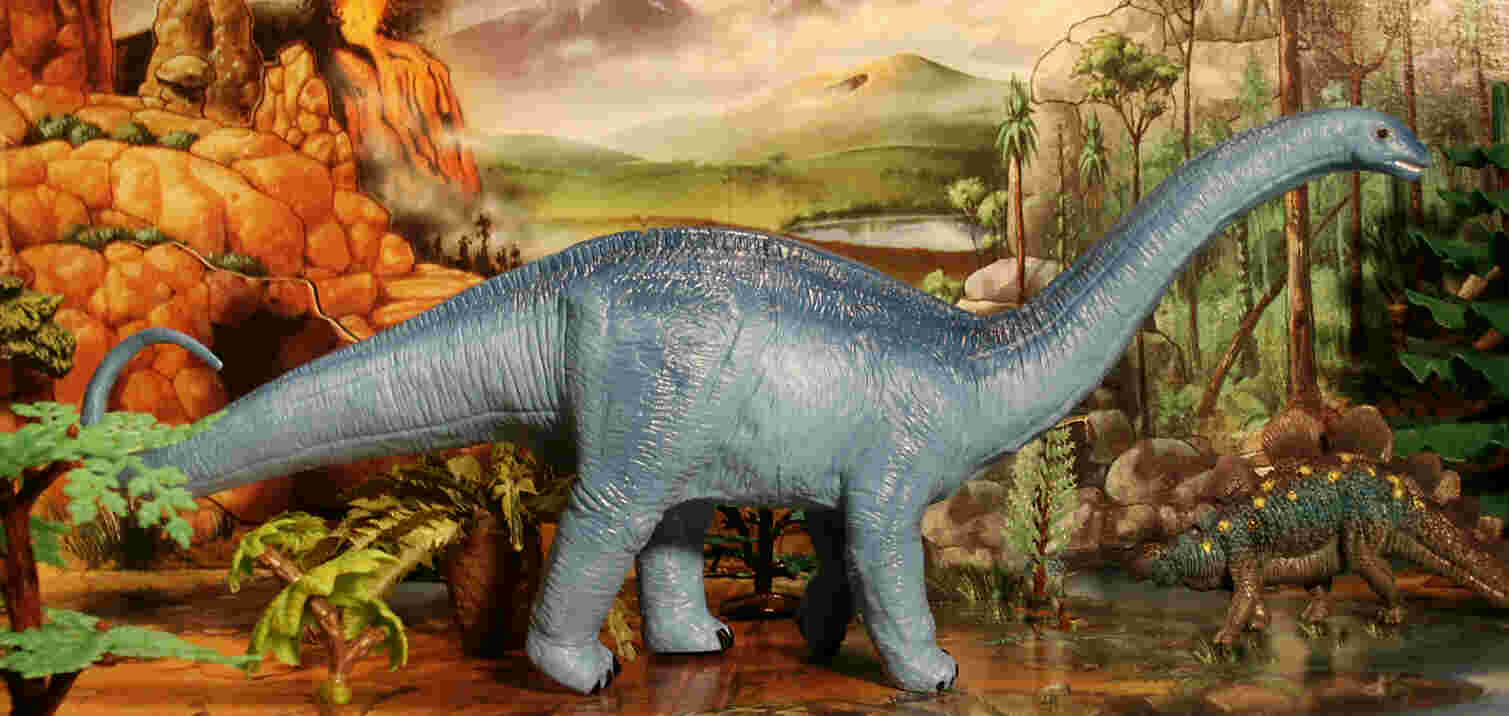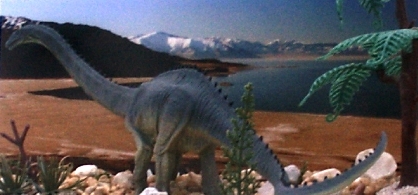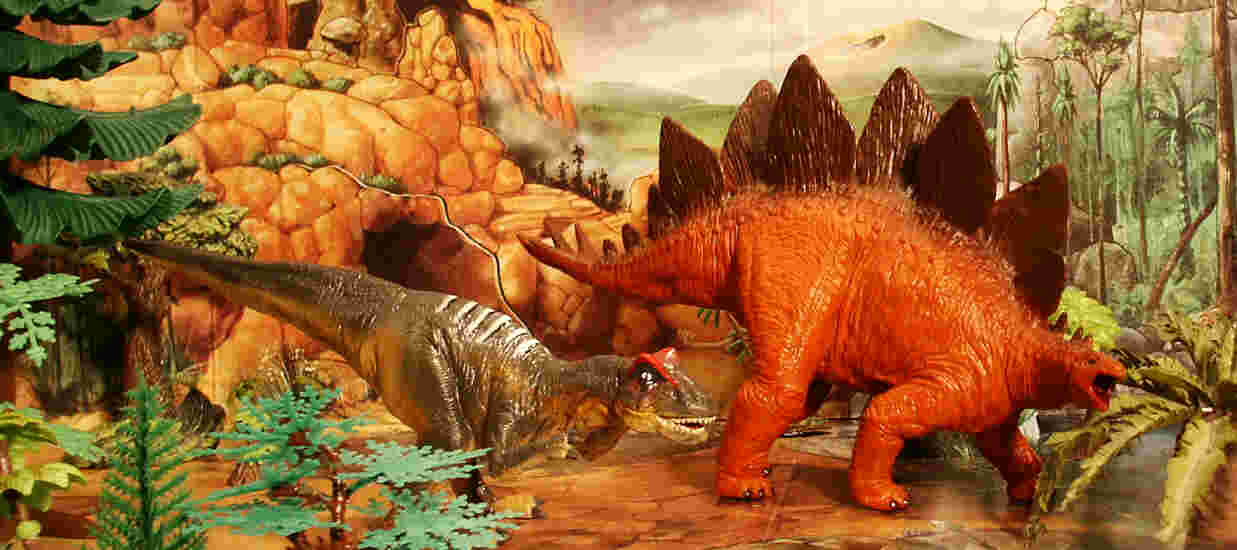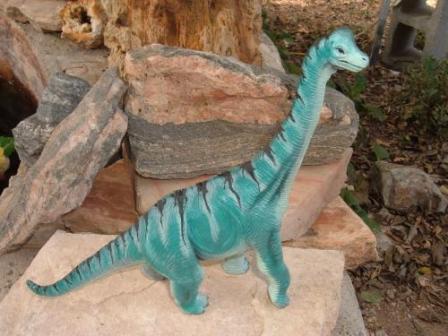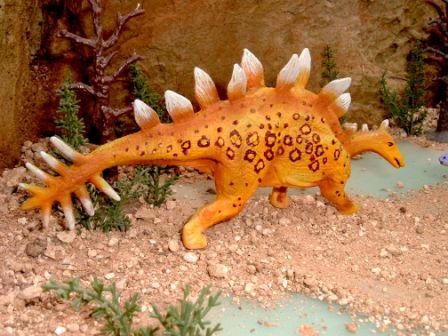from the Dinosaur Collector
Page 5 UPDATED
05/15/06
North America has large areas of exposed Late Jurassic rock.
The enormous four legged plant eaters called sauropods were the dominate
animals of the period. At least six kinds of sauropods are known to have
lived in North America in the Late Jurassic period. These are Apatosaurus (Brontosaurus), Camarasaurus, Haplocanthosaurus, Diplodocus,
Barosaurus and Brachiosaurus. There are also several diplodicids known from incomplete skeletons..
Vinyl is recent as a material for dinosaurs. Quality varies from
reproductions by the Kaiyodo , Tsukuda and Horizon companies to the many
unattributed and inexpensive bin style figures from China.
Many vinyl figures are mismolded giving a starved or pinched look. The joined
parts are often mismatched and poorly joined with glued running everywhere.
The figure can be pulled apart the body stuffed with filler ( newspaper works
well). Vinyl is soft and lends itself to modification and can often be
customized by enthusiasts. This is accomplished by placing in hot
water or using a hair dryer. This make s the vinyl easy to trim and reshape.
The limbs can be repositioned when heated and wire can be added to hold the
position when cooled. This allows the often surprising good design of the
figures to be visible.
Apatosaurus (Deceptive reptile) at 70 - 90 feet long, roamed the western part of North America from
Montana to Baja California. Not a common animal and perhaps more solitary
than its more slender relatives. Better know by its junior synonym
as Brontosaurus.
Apatosaurus from the Galaxy Toys Great Dinosaur series distributed by
Safari.
Waiphoon
Stegosaurus.
Track ways have produced some interesting speculation about the behavior of
sauropods. They seem to move in small groups indicating they were social
to some extent. You would expect large animals to have large ranges and
migrate regularly. The different size of the foot prints of some track
ways have suggested that young animals traveled with the group perhaps even were
protected by being in the center of the group. Other track ways seem to
suggest young animals traveled in groups on their own. The reassessment of
fossils previously identified as adolescent animals as adults of dwarf species
may indicated herds of mix animals or herds of the dwarf groups. They seem
generally to like dry arid environments. The plants were mostly conifers
and their allies. Typically these are plants that grow slowly, whose
foliage contains chemicals that make them hard to digest and have a low food
value. The Diplodocus and its relatives had pencil like teeth that
wouldn't have allowed the food to be chewed. They may just have acted as
rakes to help get to pants to their giant stomachs were the the food was
fermented to break down the chemical defenses. Large stones found
associated with sauropod fossils have been identified as gastroliths. They
would have been swallowed and then would have helped break down the plant
material is the gut and maybe help mix it around.
Front is the green JASMAN diorama Apatosaurus while back in the Laramie Apatosaurus. Next another Larmie with a yellow Toys R Us bin figure
from China which has the suggestion of the fleshy spines along the back
recently associated with some sauropod finds
Diplodocus was about 88 feet long but lighter, more common and more
social than Apatosaurus. Since sauropods continued growing Seismosaurus and Supersaurus at 130 to 150 may have been old individual Diplodocus or its
close relative Barosaurus. Seismosaurus ; found in Colorado is known from a few bones. It is estimated to have reached 116 feet long.
Seismosaurusfrom the Kabaya Collectors Club. The back drop is theAllDinos.com Giants of the Jurassic Play set.
Above are a pair of Laramie
Diplodocus. The middle scene contains a
Kaiyodo Allosaurus and two bin stegosaur figures. To the far right are two
of the
Diplodocus from the large bin figures JASMAN distributes.
Camarasaurus was the most common sauropod and possibly one of the earliest to
appear. Smaller at about 30 - 60 feet than many others. Remains of many young have
been found. From track evidence some sauropod young seem to have lived in
groups separate from adults. The young were probably the main prey for the
the theropods Allosaurus and Ceratosaurus. Adults would been dangerous
prey.
Waiphoon figures from China are examples of the great designs that can be
found in low cost vinyl figures. The
Allosaurus and
Camarasaurus are Waiphoon figures. The
Ceratosaurus is from a Dollar Store set while the
Stegosaurus in from a popular 4 inch series marketed by Boley and other
companies. Then a
Kaiyodo Camarasaurus with a
Stegosaurus and
Allosaurus from a Waiphoon set. Last three "adolescent" diplodocids.
Allosaurus (Different Lizard) 30 - 36 feet, perhaps larger if some
bones assigned to other dinosaurs are actually Allosaurus. There fossils
assigned to Allosaurus fragilus are probably from two distinct species.
Allosaurus from TS Toys has a strong resemblance to the BBC's Walking with
Dinosaurs Big AL. Galaxy Wild Dinosaurs Stegosaurus stenops from Safari.
Something
about the Late Jurassic must have made being big a real advantage. Diplodocus
(double beam) is often described as the longest dinosaur at around 80 feet.
It though to have been a relatively common dinosaur and social.
Pangaea still hadn't broken up so a combination of a larger rang, arid
environment and plants with low food value may have favored large size.
There may have been a relatively small number of adult animals migrating over
very large ranges. One idea is that the the diplodocids were boom feeders.
They their long necks would have allowed them to feed low over great areas
without moving. It has been suggested that their were parries of ferns
covering the Jurassic. While ferns may well have common in the well
watered areas they don't typically do well in arid settings. Cycads and
cycadoids while present were not abundant enough to support larger animals.
The flora was different from today and larger areas that today are populated by
grasses may have been barren in the Mesozoic.

From
the Klein Welka Prehistoric Park in Germany Diplodocus.
Brachiosaurus (Arm Lizard) is distinct from the diplodocids by having a robust skull with strong teeth. It also had front legs that were longer than back the reverse of other sauropods.
Custom painted hollow vinyl bin figures, PHOTOs AND ART WORK BY....Fred R Hinojosa the stegosaur found in playsets bears a strong likeness to the
Battat figure.
Stegosaurus ungulatus is one of several less common stegosaurs found in North America in the Jurassic. The plates were smaller and there were 8 spikes.
Previous Page 4 |
More Pages from the Morrison
|
|
